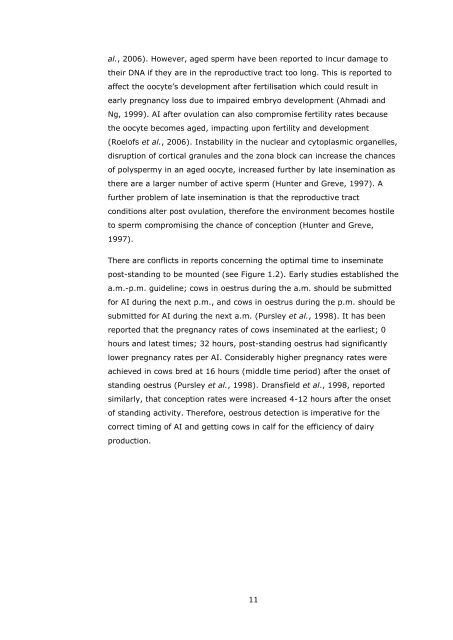novel approaches to expression and detection of oestrus in dairy cows
novel approaches to expression and detection of oestrus in dairy cows
novel approaches to expression and detection of oestrus in dairy cows
Create successful ePaper yourself
Turn your PDF publications into a flip-book with our unique Google optimized e-Paper software.
al., 2006). However, aged sperm have been reported <strong>to</strong> <strong>in</strong>cur damage <strong>to</strong><br />
their DNA if they are <strong>in</strong> the reproductive tract <strong>to</strong>o long. This is reported <strong>to</strong><br />
affect the oocyte’s development after fertilisation which could result <strong>in</strong><br />
early pregnancy loss due <strong>to</strong> impaired embryo development (Ahmadi <strong>and</strong><br />
Ng, 1999). AI after ovulation can also compromise fertility rates because<br />
the oocyte becomes aged, impact<strong>in</strong>g upon fertility <strong>and</strong> development<br />
(Roel<strong>of</strong>s et al., 2006). Instability <strong>in</strong> the nuclear <strong>and</strong> cy<strong>to</strong>plasmic organelles,<br />
disruption <strong>of</strong> cortical granules <strong>and</strong> the zona block can <strong>in</strong>crease the chances<br />
<strong>of</strong> polyspermy <strong>in</strong> an aged oocyte, <strong>in</strong>creased further by late <strong>in</strong>sem<strong>in</strong>ation as<br />
there are a larger number <strong>of</strong> active sperm (Hunter <strong>and</strong> Greve, 1997). A<br />
further problem <strong>of</strong> late <strong>in</strong>sem<strong>in</strong>ation is that the reproductive tract<br />
conditions alter post ovulation, therefore the environment becomes hostile<br />
<strong>to</strong> sperm compromis<strong>in</strong>g the chance <strong>of</strong> conception (Hunter <strong>and</strong> Greve,<br />
1997).<br />
There are conflicts <strong>in</strong> reports concern<strong>in</strong>g the optimal time <strong>to</strong> <strong>in</strong>sem<strong>in</strong>ate<br />
post-st<strong>and</strong><strong>in</strong>g <strong>to</strong> be mounted (see Figure 1.2). Early studies established the<br />
a.m.-p.m. guidel<strong>in</strong>e; <strong>cows</strong> <strong>in</strong> <strong>oestrus</strong> dur<strong>in</strong>g the a.m. should be submitted<br />
for AI dur<strong>in</strong>g the next p.m., <strong>and</strong> <strong>cows</strong> <strong>in</strong> <strong>oestrus</strong> dur<strong>in</strong>g the p.m. should be<br />
submitted for AI dur<strong>in</strong>g the next a.m. (Pursley et al., 1998). It has been<br />
reported that the pregnancy rates <strong>of</strong> <strong>cows</strong> <strong>in</strong>sem<strong>in</strong>ated at the earliest; 0<br />
hours <strong>and</strong> latest times; 32 hours, post-st<strong>and</strong><strong>in</strong>g <strong>oestrus</strong> had significantly<br />
lower pregnancy rates per AI. Considerably higher pregnancy rates were<br />
achieved <strong>in</strong> <strong>cows</strong> bred at 16 hours (middle time period) after the onset <strong>of</strong><br />
st<strong>and</strong><strong>in</strong>g <strong>oestrus</strong> (Pursley et al., 1998). Dransfield et al., 1998, reported<br />
similarly, that conception rates were <strong>in</strong>creased 4-12 hours after the onset<br />
<strong>of</strong> st<strong>and</strong><strong>in</strong>g activity. Therefore, oestrous <strong>detection</strong> is imperative for the<br />
correct tim<strong>in</strong>g <strong>of</strong> AI <strong>and</strong> gett<strong>in</strong>g <strong>cows</strong> <strong>in</strong> calf for the efficiency <strong>of</strong> <strong>dairy</strong><br />
production.<br />
11
















